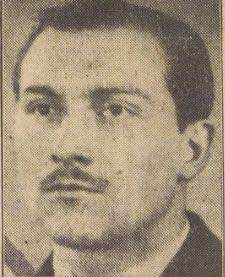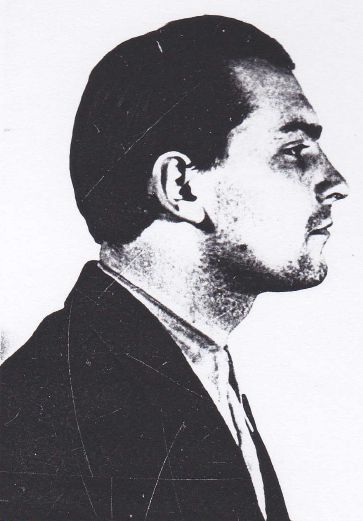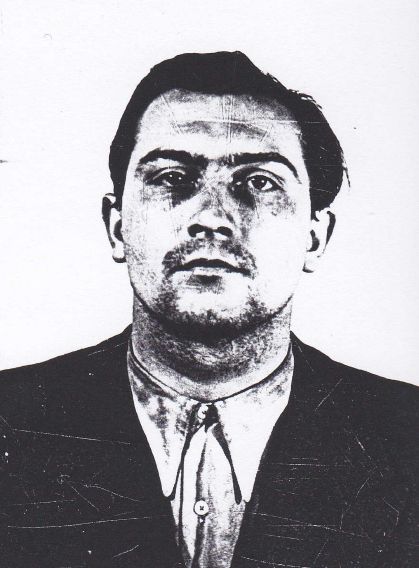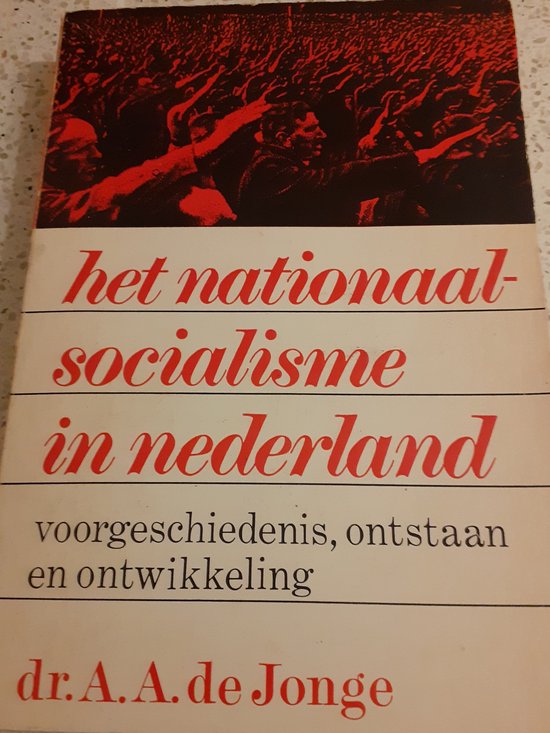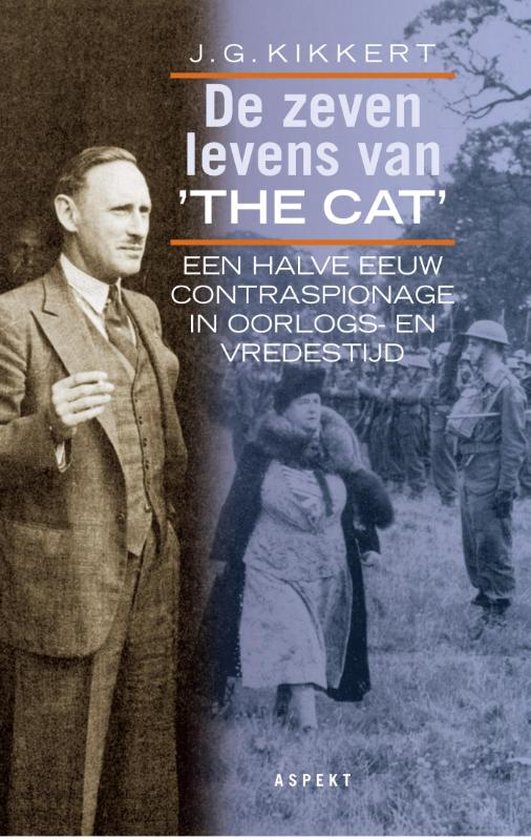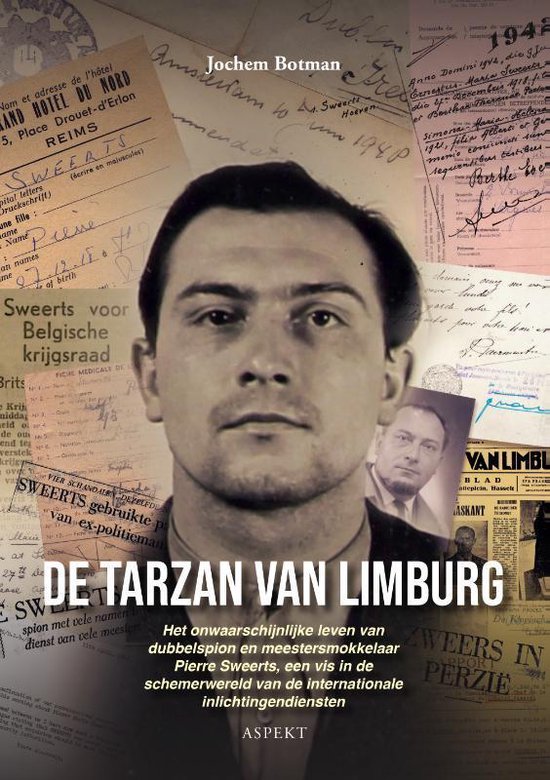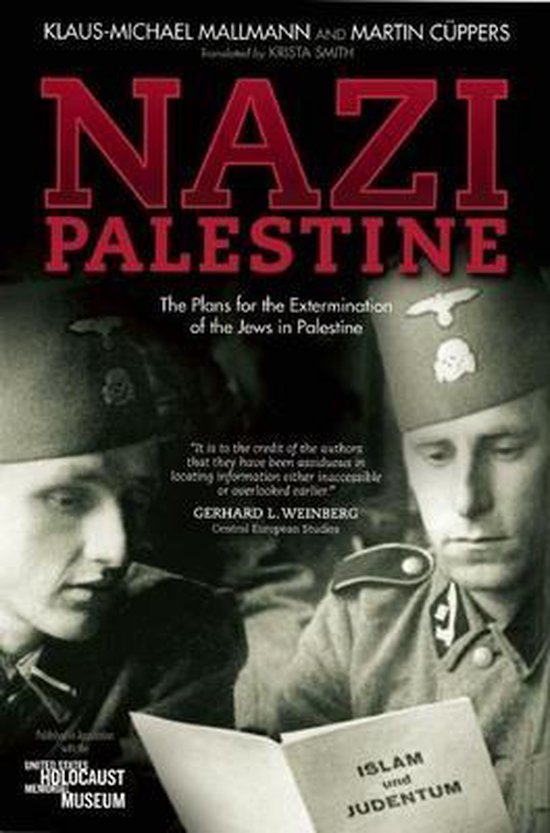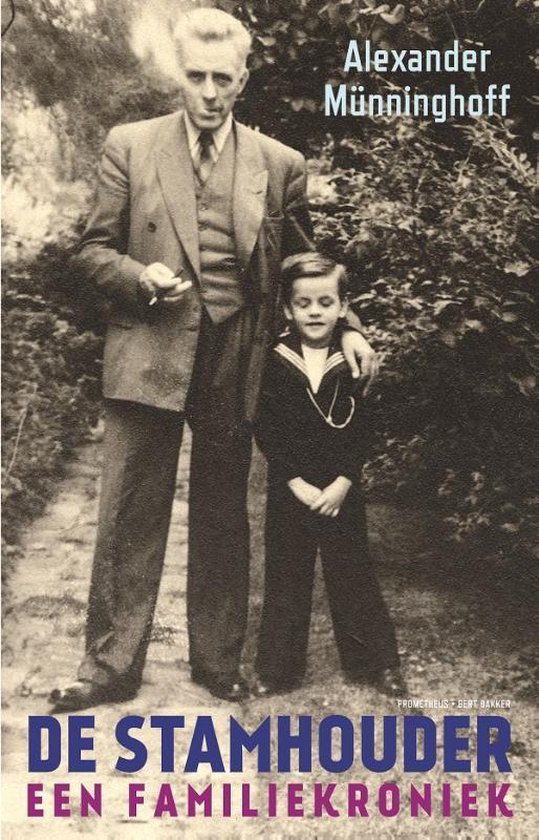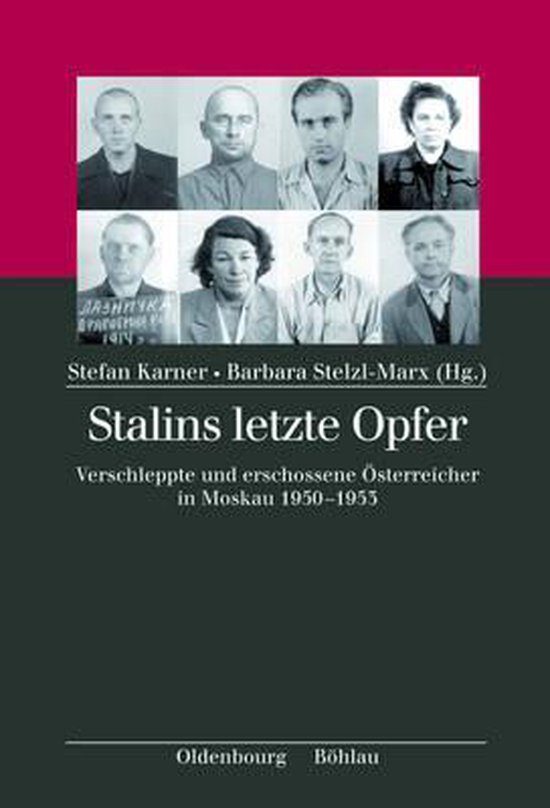Introduction
The Belgian Pierre Marie Ernest Sweerts, although sentenced to death in his own country, was initially not arrested after the Second World War. This was due to the fact that he had offered his services while working within the Reichssicherheitshauptamt (RSHA; the police-and security service of the SS). After the war he was employed as interrogator in special camps that were involved with mopping up the werewolf organisations (nazi underground resistance groups) and the hunting down of Abwehr- and SD-members in POW- and refugeecamps. After this he was employed in the Nederlandse Fiscale Recherche, the Dutch tax detective force, where he worked in tracing capital that had been embezzled by collaborators and nazis. De auteur van dit artikel schreef over dezelfde persoon het boek De Tarzan van Limburg (ISBN: 9789463387927).
Definitielijst
- Abwehr
- Term used for the German military intelligence unit during the WW1 and WW2. From 1935 onwards under command of Admiral Wilhelm Canaris. The organisation often came into conflict with other secret services such as the SD and the Gestapo. During World War 2 under Canaris frequently a source for conspiracies against the Nazi regime until in 1943 a major conspiracy by a number of prominent members of the Abwehr was discovered and the Abwehr was placed under command of Himmler. After the assassination attempt on Hitler in 1944, Canaris was discharged and the Abwehr was dissolved. The conspirators and Canaris were prosecuted and in 1945 they were executed atc oncentration camp Flossenburg.
- nazi
- Abbreviation of a national socialist.
- POW
- Prisoner of War.
- resistance
- Resistance against the enemy. Often also with armed resources.
- RSHA
- Reichssicherheitshauptamt. The central information and security service of the Third Reich.
Images
Before 1941
Pierre Marie Ernest Sweerts was born on 27 September 1918 in Sint-Joost-ten-Node (Brussels), Belgium. Already at the age of 13 Pierre Sweerts was actively involved in sport, especially swimming was his passion. On secondary school he was swimming champion. At the age of 18, in 1936, it seemed for a while that he would be a member of the Belgian swimming- and waterpolo team that represented Belgium in the Olympic Games that year.
One year later he was drafted for military service. He ended up in the artillery school in Fort de Suarlée, a fortress in the defensive belt around Namur. At the end of 1938 he got a position with the General Staff of the 2de Gemotoriseerde Cavalerie Divisie or 2de Motorized Cavalry Division. At the end of 1939 he was transferred to the Flemish regiment Bourg-Leopold (Leopoldsburg).
On the eve of the German invasion he was in Lanklaar, a village on the border with Dutch Limburg. In the skirmishes that followed Sweerts was hit in his belly. He was evacuated to Southern France to recuperate from his wounds. On 12 August 1940 Sweerts was discharged from hospital and returned to his parents via Brussels to Sint-Joost-ten-Node. Because of discontent with the German occupation he joined the intelligence service ZERO in Sint-Joost-ten-Node . He did this of his own accord and after advise of a befriended attorney mr. Michel Goffart. This intelligence service concentrated on collecting economic and administrative information in occupied Belgium. The service had a large network of hiding places and escape routes to abroad and cooperated with the southern Dutch-Belgian Wim-group commanded by adjudant Vermeulen (later the Geheime Dienst Nederland or Secret Service in the Netherlands). It had links to secret services in London. During the war this intelligence service remained active.
In Brussels the leaders of ZERO (William Ugeux, Fernand Kerkhofs and Albert Hachez) closely cooperated with the founders of the illegal magazine La Libre Belgique, among them the before mentioned friend attorney of Sweerts, mr. Michel Goffart. After a failed raid on an armory where one of the members was arrested, the group of Sweerts was dissolved out of fear of reprisals. Sweerts went into hiding. According to post war statements of Sweerts he volunteered for the Waffen-SS. He was advised to do this by a friend of the family. The Waffen-SS was recruiting at the moment and wanted to win foreign volunteers over for the coming war in the east. This offered an excellent chance to give intelligence to the resistance. However, was Sweerts really such a patriot? Was he, as he claimed himself, an informer for the British secret service and a resistance fighter at that time?
The post war newspaper reports on Sweerts mention an entirely different side of Sweerts in the first war year. The post war court-martial in Tongeren declared that Pierre Sweerts had been involved in financial manipulations and a number of killings in that time in his birth region De Kempen. His accomplices during these practices were two men called Hendrik Harry Bovens and Chretien Driane that formed together with him the group ‘Sweerts’. Driane clashed with Sweerts in 1940 during smuggling on the Dutch border near Maaseik. According to Driane, Sweerts, when caught, had imposted as a member of the police force after Driane was caught. He gave Driane the choice of being incarcerated or working for the Germans. Bovens was a tailor who drank too much which caused him to come into conflict with Sweerts.
Definitielijst
- Cavalry
- Originally the designation for mounted troops. During World War 2 the term was used for armoured units. Main tasks are reconnaissance, attack and support of infantry.
- invasion
- Armed incursion.
- raid
- Fast military raid in enemy territory
- regiment
- Part of a division. A division divided into a number of regiments. In the army traditionally the name of the major organised unit of one type of weapon.
- resistance
- Resistance against the enemy. Often also with armed resources.
- Waffen-SS
- Name of Military section of the SS.
In service of the SS
Whatever may be true, Sweerts signed up with the Waffen-SS in 1941. On 23 May 1941 Pierre Sweerts left for Hamburg. He ended up in the 8th company of the SS Standarte Nordwest. Sweerts was so good that he was promoted in a short time to SS-Obersturmführer in the Waffen-SS. His quick career triggered jealousy among his German colleagues. It was soon rumoured that Sweerts was a spy. An investigation was started but no evidence was found.
Nonetheless, Sweerts asked for transfer to the Amt VI Sipo and SD in Brussels a year after his enlistment. With this service, in the period of October 1942 until April 1943, he was deployed to win information about pro British groups and to gauge the mood of the Belgian population. He had to report on the morale of Belgians that worked for the Germans. Where Sweerts arrived labour conflicts arose. Sweerts was indifferent to many things which he simply ignored and augmented his salary with extortion. Nonetheless the Abwehr (the German counter intelligence service) was interested in him. He could be deployed as a secret agent. From June until September 1943 and later until February 1944 Sweerts followed various courses in Institut Wannsee (Havel Institute), Lehnitz, The Hague (Zorgvliet,Seehof) and Paris. On these schools international agents were trained that had to operate behind enemy lines. Sweerts met among others Dutch, Danes, Belgians, Spaniards and Norwegians and Arabs that were trained to be spies or saboteurs. It was here that he received his covert name Rene and identity papers on the name of "Peter Sola". Another familiar person that was trained on Zorgvliet was Maria Sassen, the eldest sister of the well known Dutch SS men Wim and Alfons Sassen.
Sweerts was incorporated in Amt VI C12 and later VI C13. He was specially trained for this in Berlin under control of the sabotage expert Otto Skorzeny and by the Grand Mufti of Jerusalem. As head of the department of Persia Sweerts had to take care of among others the arming of anti-British guerilla troops and expansion of their activities in the Middle East. In Persia he was part of the team of SS-Hauptsturmführer Roman Gamotha, codenamed "Max". The team formed part of the referate for "Arab Affairs" (C13) of Amt VI, RSHA. The entire "Norma-operation" ended in disaster. There had been betrayal. Sweerts was called back to Brussels.
Sweerts himself stated after the war that he " had defected to the British secretly in November 1943, and had been working there as a First Lieutenant with the Special Counter Intelligence (SCI)." As a double agent, he claimed, he had sabotaged, as SS-Obersturmführer in the function of referent for the Near East, together with British and Soviet agents, a weapons shipment under the code name "Norma" to pro German insurgents in northern Iraq. In the British interrogations of Sweerts however nothing of the kind can be found. It is suggested, however, that Roman Gamotha was responsible for the failure of the operation. He was supposed to have been a double agent for the British as well as for the Soviets. Around Easter 1945 in Vienna, Roman Gamotha defected to the Soviet Union. After the war he would track former members of the Abwehr.
From within the RSHA in Berlin an investigation was started into the members of the Norma-team, among whom was Sweerts. This didn't turn out a solid proof of Sweerts' alleged double role. He was however transfered to Brussels, where he received the task of training stay-behind agents for espionage and sabotage behind allied lines. This didn't yield much. In stead, he instigated, together with Gamotha, a lucrative smuggle business. In collaboration with black marketeers and art dealers, Sweerts traveled in Belgium, The Netherlands, France and Spain in civilian clothes. In his pocket he had a Sonderausweis, a special pass of the RSHA, with which he could travel freely and seal financial transactions. As a mediator Sweerts got involved in the personal financial transactions of SS-chef Heinrich Himmler and RSHA-chef Ernst Kaltenbrunner to Swiss bankaccounts through the German robber's bank Lippmann, Rosenthal & Co, that had Amsterdam as its base. These were two high ranking authorities that wanted to secure their personal interests in anticipation of the German defeat.
In Brussels, Sweerts was involved in the circuit of art dealers that smuggled robbed art to Spain. The most famous trader was the banker Alois Miedl, the personal art dealer of Hermann Goering. Miedl escaped to Spain at the end of 1944 with part of the famous Goudstikker-collection, paintings of old masters.
The allied invasion on the coasts of Normandy spoiled the lucrative business of Sweerts and Gamotha. The last shipment of watches, coffee and cognac arrived on 15 August 1944 from Paris in The Hague. On 26 August 1944 Paris was liberated and on 3 September Brussels fell. Antwerp was liberated one day later. Because of the allied advance the smuggle routes to the south had been blocked and that meant the end of the lucrative trade in scarce and luxurious products of Gamotha and Sweerts. Sweerts searched a way out. He approached his SD-chef SS-Hauptsturmführer Johann Heinrich Ahrens in The Hague with the request to map the situation in the liberated areas as a linecrosser. Ahrens was then head of the department Referat VI that was tasked with the training of spies(The Hague (Referat VI s: Seehof/ Zorgvliet) and the establishment of I-netz (Invasions-netz), an underground intelligence service that was to become operational after an allied liberation
Sweerts had to join his hiding comrades and collect information on the allied troup movements and on the morale of the Belgian population. Sweerts managed to cross the allied lines unscathed. He arrived in Antwerp safely, had his hair cut and completely refreshed, he contacted the nearest British checkpoint.
Definitielijst
- Abwehr
- Term used for the German military intelligence unit during the WW1 and WW2. From 1935 onwards under command of Admiral Wilhelm Canaris. The organisation often came into conflict with other secret services such as the SD and the Gestapo. During World War 2 under Canaris frequently a source for conspiracies against the Nazi regime until in 1943 a major conspiracy by a number of prominent members of the Abwehr was discovered and the Abwehr was placed under command of Himmler. After the assassination attempt on Hitler in 1944, Canaris was discharged and the Abwehr was dissolved. The conspirators and Canaris were prosecuted and in 1945 they were executed atc oncentration camp Flossenburg.
- collaboration
- Cooperation of the people with the occupying forces, more generally spoken the term for individuals who cooperate with the occupying force is collaborator.
- invasion
- Armed incursion.
- RSHA
- Reichssicherheitshauptamt. The central information and security service of the Third Reich.
- Sipo
- ”Sicherheitspolizei”. Combination (since 1936) of the Gestapo and criminal police.
- Soviet Union
- Soviet Russia, alternative name for the USSR.
- Waffen-SS
- Name of Military section of the SS.
Defection to the British
On 10 or 11 December 1944 Sweerts defected definitively to the British. The British were very interested in Sweerts. His thorough knowledge of the RSHA-apparatus and the international spy schools made him a splendid candidate to mop up underground werewolf organisations that the Germans had left in Belgium and The Netherlands. He was not passed yet however. Before he could be declared entirely denazified he had to be thoroughly interrogated by MI6 in England.
Through Antwerp and Brussels he arrived in London. Shortley thereafter he ended up in interrogation camp 020 (Latchmere House) near Surrey. His knowledge of the German intelligence apparatus and from clandestine financial transactions from high ranking nazi-authorities to Switzerland and Spain (the so called covert roads of enemy property to neutral countries) was extremely useful.
In April 1945 Sweerts went to work for captain W.W. Pidcock from the 106 Special Counter Intelligence and his liaison officer Hendrik Siedenburg. Initially, Sweerts was going to work as a double agent for the team, but the German capitulation prevented this and he became interrogator of former functionaries of the German intelligence apparatus in Fort Blauwkapel near Utrecht and the camp 0 – 3 – 0 under the name of Van der Molen. 0 - 3 - 0 was a special camp for extremely important spies and traitors that the British security had established on the estate De Oxerhof near Deventer.
In the final months before the German surrender Sweerts was again busy with smuggling. He gained large profits on the black market and these were even increased when he managed to penetrate the Dutch customs in Noord-Brabant, where he was appointed as a detective. He managed to appoint a wachtmeester of the rijkspolitie, a young man from Bilthoven, as an assistent. He was even paid in his function as wachtmeester by the Department of Justice! Sweerts had him made all kinds of rubber stamps and disposed of cars, weapons and uniforms that would help him in his function.
His biggest catch as customs official of the Nederlandse Fiscale Recherche, the Dutch Financial Investigation, was the arrest of banker Otto Rebholz. A curious fact was,however, that this Rebholz was the man for whom Sweerts dealed as an intermediary during the war in foreign currency and stocks to foreign firms. The proceeds of these were expended in Spain for purchasing the metal tungsten which was desperately needed for the German war industry. Besides, he was at the time involved in Brussels in the circuit of art dealers that smuggled stolen art to Spain. The best known dealer was the banker Alois Miedl, the personal art dealer of Hermann Goering. Miedl escaped at the end of 1944 with part of the famous Goudstikker-collection(paintings from old masters) to Spain.
Sweerts' major employer, however, remained the SCI. On a regular basis he reported to his chief, colonel C. Seymour, on his main office in Hollandsche Rading, or in the factory of British American Tobacco (BAT) on the Asterweg 13 - 15 in Amsterdam Noord. The BAT was,especially between the world wars, one of the main covers of the international operations of the SCI. In Amsterdam, Seymour already had a position in the BAT before the Second World War and had been involved from the beginning in the activities during the war of the Dutch and British secret agents that had been sent to the occupied Netherlands. After the war he returned to The Netherlands and it wasn't a miracle that Sweerts, upon his arrest, had an identity paper with him that was signed by Seymour, which by the way was false.
De Alkmaarse Courant reported in May 1949 the following about Sweerts: "At the end of the war he professed all kinds of strange jobs, for the British he requisitioned cars in Germany until the Security Group of Pidcock in The Netherlands was suspended in 1946. He nevertheless remained in this trade of foreign cars until his short career with the Dutch Customs. Sweerts worked in this time under the pen-name Sola, René, Le Cocq, Van Donk, Du Bois, Van Beveren and Fort." Sweerts remained under the protection of Siedenburg who by now was working for the Bureau Nationale Veiligheid (BNV; the first post war predecessor of the current AIVD), the Dutch Secret Service.
Sweerts remained in "service" of the BNV until Siedenburg resigned. He subsequently focussed on the trade in identity papers, cars, intelligence files and even considered starting his own intelligence service. The trade in identity papers was very lucrative and there were enough Dutch and Flemish collaborators and former SS men that sought to escape to for instance, Germany, Spain and Argentina. Among these was the son of the industrialist Joannes Maria Josephus Antonius Münninghoff, Frans, a former soldier on the Eastern Front, that wanted to avoid persecution and evade to Latin America.
Definitielijst
- capitulation
- Agreement between fighting parties concerning the surrender of a country or an army.
- nazi
- Abbreviation of a national socialist.
- RSHA
- Reichssicherheitshauptamt. The central information and security service of the Third Reich.
Images
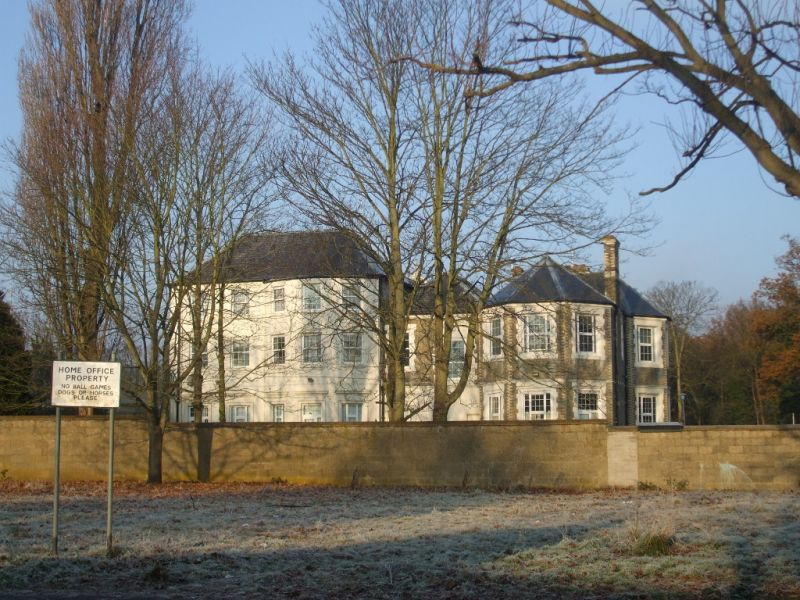 Latchmere House near Surrey, where interrogation camp 020 was located.This was where Sweerts was interrogated. Source: Ken Bailey.
Latchmere House near Surrey, where interrogation camp 020 was located.This was where Sweerts was interrogated. Source: Ken Bailey.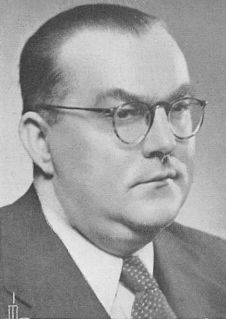 The banker Otto Rebholz, the biggest catch of Sweerts being a customs detective. Source: IISG.
The banker Otto Rebholz, the biggest catch of Sweerts being a customs detective. Source: IISG.Arrest and release
In the end, the trade of Sweerts was discovered. Sweerts was detained in the autumn of 1946 by the Haarlemse recherche, the police in Haarlem, in a hotel in Haarlem, an address that the BNV had given him as a hide out. The house search turned out four cars, a radio transmitter for an airplane, stenguns with ammunition, a breviary and 68 blank Dutch passports. Besides this, large amounts of files of the BNV and the Politieke Recherche Afdeling or Political Research Department (PRA; tasked with the tracking of collaborators ) were found, that Sweerts had received through a certain "Smink" in The Hague. Sweerts was locked away for the time being in the police station Koudenhorn in Haarlem. Shortly thereafter Sweerts was condemned for possessing a false passport and three unregistered cars. The BNV- and PRA-files nor the blank passports nor the weapons were mentioned.
A few days after his arrest in The Netherlands, Sweerts was condemned to death in absentia by a Belgian court-martial in Tongeren. This sentence was for enlisting in foreign service against Belgium or against its allies. The Belgian charge was his service period with the Waffen-SS, treason, being member of an enemy intelligence service, theft, murder and mistreatment or accessory to mistreatment. Two former members of the group-Sweerts (Bovens and Driane) known in Belgian Limburg by the name band of Maaskant, were condemned to death because of their actions by post war Belgian courts. During the trial against the Sweerts-group all blame was cast upon Sweerts. Bovens as well as Driane were condemned to death after the war. Was this also the end of Sweerts?
Apparently not. Although the Haarlem police had communicated the capture of Sweerts immediately to the Sûreté de l'État in Brussels, the Belgian authorities didn't ask for his extradition. After deliberation with MI6, the Dutch authorities decided not to prosecute Sweerts any further. In stead, after one and a half year of imprisonment, in June 1948, Sweerts was given the opportunity to leave The Netherlands as third mate on a Greek smuggling ship under Panamese flag.
After his release Sweerts claimed:"In June 1948 I was released without a pass. I then enrolled, out of despair, as third mate on a Greek ship that sailed under Panamese flag. Internationally seen I didn't require a passport for that."
Thanks to mediation of high authorities within the security services, mainly the British, and the brother of Joannes Münninghoff, Wim (Wilhemus Lambertus Christianus Maria) Münninghoff from Voorburg, Sweerts was released. The British MI6 stated in 1947 that Sweerts never had joined that service. The Belgian authorities let Sweerts know that he could go under the condition that he would never again set foot on Belgian soil. Sweerts, was declared a persona non grata with a very dark history by the Dutch authorities and was asked to leave the country. South America would be a good destination for him. Hadn't he guided collaborators there before? Sweerts didn't enroll on a Greek ship as the post war papers suggested, but on a cutter.
Definitielijst
- Waffen-SS
- Name of Military section of the SS.
Activities for the Service Hacke-Elsinga
Sweerts is supposed to have landed in England after a violent storm. Via Gravesend he soon returned to The Hague. On his return in The Netherlands he started up relations with a private intelligence service Hacke-Elsinga in Rotterdam, where he met a dismissed state investigator, D. van Donk and a certain Schallenberg, who died because of shady reasons, and a number of intelligence personnel that was involved in the Ambonese endeavour for independence. Sweerts as well as Schallenberg came from the same German intelligence apparatus and offered their service to Allied intelligence services (espionage and counter espionage). After the war these practices continued and they were involved in espionage and counterespionage for various (private) intelligence services in and around The Netherlands.
The service Hacke-Elsinga consisted of four branches: a documentation-, a propaganda-, a financial branch and finally an intelligence branch, which was headed by former resistance and christian trade union leader Tjerk Elsinga. Elsinga, in his post war period as head of the Politieke Opsporingsdienst (POD), the Political Investigation Department in Rotterdam, had assembled a group of unreliable folks around him, that were fired upon his leaving the POD because of fraud, blackmail, embezzlement and many other dubious practices. This didn't prevent Elsinga from employing them once again in the private information- and investigation bureau Securitas that he grounded.
The bureau consisted of former unsatisfied former underground men,former members of the Landelijke Organisatie voor hulp aan onderduikers (LO) or "National Organisation for help to persons in hiding" and the Landelijke Knokploegen (LKP’s) or National strong-arm squad, that were not very sympathetic towards democracy and especially resented the post war government policy. Securitas wasn't to last long and in 1947 it merged with the combination Hacke –Elsinga. Dr. Ir. A.H.W. Hacke, a virulent anti-communist, enjoyed more regard because already before the outbreak of the war he had had support from the corporate world and on top of this he was a member of the Tweede Kamer, the Dutch parliament, for the Partij van de Vrijheid, a precursor of the VVD which was grounded in 1948. The foundation Stichting Opleiding Arbeidskrachten Nederland (SOAN), established by them in 1947, and headed by these two bosses, disposed of relations that ranged from government level and security services up into the corporate world.
Sweerts became chief of the bureau of Elsinga’s intelligence branch. He got involved immediately in a number of dirty affairs that mainly had to do with the smuggling of black effects to abroad, committing of fraud and blackmail. Besides, Sweerts was involved under command of black marketeer Peter Louis Henssen in tracking German capital in The Netherlands. To this end Sweerts cooperated with shady types as ‘Joop’, ‘Bill’ and ‘Jos the Killer’, all black marketeers, failed detectives, former knokploeg leaders and underworld figures.
The before mentioned intelligence co-operator Friedrich Schallenberg was found dead on 14 September 1949 in a shallow ditch. Suicide was deemed possible, but the circumstances were too suspicious. Sweerts had been seen at Schallenbergs house as well as near the ditch. Besides, Sweerts had used the passport of Schallenberg, after his death, in Paris. Schallenberg, a trader in sporting goods, had been a spie during the war. He worked with the German Feldgendarmerie and regularly visited the SD-Referat IV B 4 on the Nieuwe Parklaan in The Hague, where among others, Joop Out and Andries Riphagen had been stationed. Schallenberg disposed of the records of the so called cartotheek, a source that contained the names of wealthy Jews and those who had a considerable fortune in effects, ornaments and houses.The confiscated possessions were managed by the robbers' bank Lippmann, Rosenthal & Co. Schallenberg knew that upon intake of the confiscated valuables not everything was handed over and that German as well as Dutch agents enriched themselves with it. The pilfered booty was mostly posted on special hiding places.
It was the Service Hacke-Elsinga that pressured Schallenberg to give up his data. Schallenberg seemed willing to give information for a considerable sum. Sweerts had to exert pressure during the negotiations. Shortly after their meeting Schallenberg was found dead in the morning of 14 September 1949 in a shallow ditch. The notebook with all incriminating information on collaborators and companies that had thrived during the war was lost. The police investigation ended with the conclusion that Schallenberg had drowned. High ranking authorities knew that, with a thorough investigation, too much information would surface concerning parties that had an interest in the death of Schallenberg. The topic of the lost capital of Dutch Jews was not supposed to come into the open. That was a part of the war history that would have to be polished carefully. With the death of Schallenberg that information would never surface. Up until today the Schallenberg affair remains an unsolved case.
Definitielijst
- democracy
- From the Greek: demos (the people) kratein (rules). Democracy is a form of government elected by the majority of the people in which the people can check on the leaders and have the government resign in case a majority of the people no longer agrees with the government.
- Jews
- Middle Eastern people with own religion that lived in Palestine. They distinguished themselves by their strong monotheism and the strict observance of the Law and tradition. During World War 2 the Jewish people were ruthlessly persecuted and annihilated by the German Nazis. . An estimated 6,000,000 Jews were exterminated.
- knokploeg
- Literally ‘assault team’ (abbreviated KP) and the term used by the Dutch resistance for the many locally organized armed fighting groups that undertook various resistance actions, ranging from sabotage and assassination to stealing food stamps and forging false ID documents.
- propaganda
- Often misleading information used to gain support among supporters or to gain support. Often used to accomplish ideas and political goals.
- resistance
- Resistance against the enemy. Often also with armed resources.
Westerling-affair
Sweerts remained operating in shady area until he came into the news once again in the so called Westerling affair, during a collision in May 1951 in Antwerp. Raymond Paul Pierre Westerling (1919-1987) was known as The Turk or The Murderer of Celebes (Sulawesi). He was raised in Turkey hence the nickname The Turk. In 1944, he was part of the staff of the Prinses Irene Brigade. In June 1945, Westerling reported for the struggle in the Dutch East Indies. He went over to the Royal Netherlands East Indies Army(KNIL) and was appointed reserve second lieutenant. He ended up in the corps Insulinde, that was part of Force 136 on Ceylon, an organisation that executed commando actions in enemy territory. Westerling cooperated closely with the Ambonese.
In December 1946 he was sent to South-Celebes in order to quell insurgency there. In the course of 1949 rumour was spread that he was a leader of a sizeable army force under the name APRA (Angketan Perang Ratu Adil), the legion of the righteous monarch. A month after the transfer of sovereignty (27 December 1949), on 23 January 1950, he attempted an attack on Bandoeng. APRA members as well as 300 former KNIL members took part. Its aim was to topple the reign of the Indonesian president Soekarno. It ended in a failure. Westerling had to hide out and was evacuated to Singapore in a British Catalina flying boat. From there he reached Brussels in August 1950. In The Netherlands and in Belgium he was received with cheers by conservative circles as a national hero. In Indonesia he was wanted for murder.
In Belgium,representatives of the Republik of South Maluku (RMS) and the Moluccan Stichting door de Eeuwen Trouw (established in 1950) contacted Westerling to execute a new military action on Ambon or Ceram, also known as the Ambonese help action. Sweerts was also contacted because he was an expert in many fields; a prominent international arms smuggler with international contacts in various intelligence services, the army and the corporate world. Sweerts lived then under the covername Le Cocq. It was under that name that the people from Door de Eeuwen Trouw got to know him. The financial advisor of the bureau of the RMS, the director of a The Hague newspaper company, had introduced them a year before to Sweerts.
The plan was to initiate an uprise on Ambon. Sweerts started, under the shelter of his covernames, to procure weapons, a Lockheed airplane and various radio transmitters and to collect them in Brussels. Sweerts' expenses were covered by the RMS. He even received a diplomatic passport for this. Sweert's function was State Secretary for War and General Affairs under the name Pierre Aumena, in order to give a legitimate character to his missions abroad as representative of the Moluccan cause. Sweerts wasn't very secretive in these matters. Due to his immoderate behaviour in Brussels he drew too much attention to his person. The Indonesian ambassador in Belgium and the Indonesian Minister of Foreign Affairs Anak Agoeng, pressed the Belgian government for measures. The preparations for the Ambonese help action had become news. Indonesia asked for the extradition of Westerling. Sweerts understood that Westerling had to disappear from Belgium as soon as possible. He was helped by a civil servant of the Dutch consulate in Antwerp, Meine Pot, who delivered a false Dutch passport for Westerling without knowledge of his superiors. In this way, Westerling escaped by plane to Tanger under the name of Petrus Lambrecht. Sweerts also had to leave. From the Stichting door de Eeuwen Trouw an investigation was started into financial malversations. Sweerts had bartered away the funds for the help action on badly usable military materiel and especially for his own profit.
In the night of 17 to 18 April,1951, an accident took place between a Belgian military car and a black Buick. In the civilian car were "H.J. Ronken" (Sweerts), a ship broker from Rotterdam and "Simone M. Hoeven" (the wife of Sweerts) from Utrecht. The car belonged to Meine Pot, the civil servant of the consulate general of The Netherlands in Antwerp. Pot was already wanted for stealing Dutch blank passports and other documents for the group of Raymond Westerling. Sweerts' identity was only later traced. Notwithstanding this, the scandal made it to the front pages. From newspaper articles from that time the RMS board knew about the practices of Sweerts. Sweerts was a large crook. Sweerts had had, before his arrest on 3 May 1951, his car prepared for a long journey and had taken with him all the money of the bureau of the RMS that he disposed of. He is said to have had plans to travel to South America. Upon his arrest he had an amount of 499,000 Dutch guilders with him.
Definitielijst
- KNIL
- “Koninklijk Nederlands-Indisch Leger” meaning “Royal Netherlands East Indies Army” (1830-1950). Name of the Dutch army in the Netherlands East Indies.
Images
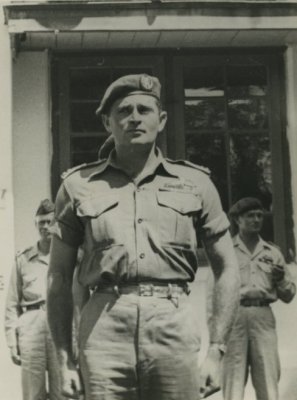 Raymond Westerling in 1948. Sweerts helped him to escape after his return from Indonesia and by doing so prevented Indonesia from prosecuting him. Source: Beeldbank NIMH.
Raymond Westerling in 1948. Sweerts helped him to escape after his return from Indonesia and by doing so prevented Indonesia from prosecuting him. Source: Beeldbank NIMH.Prison sentence and unknown fate
Sweerts was jailed in the Begijnenstreet in Antwerp. He would face trial there for a number of civil and criminal proceedings, mainly the car accident, having a false passport and illegal possession of a firearm.
The Dutch consulary civil servant Meine Pot and Sweerts, were found guilty, by the Antwerp judge, of forgery and the stealing of nine passes on the Dutch consulate in Antwerp. This was in aid of Westerling.Besides, Sweerts was found guilty of forging an international driver's license and logement letters. Pot however came into consideration for reduction of the sentence. Thanks to him, Sweerts was entrapped near Hotel Scheers in Brussels and was arrested by the Belgian police.
A week later he was transferred to Liège. On 19 June 1951 Sweerts had to appear before the Military Court in Liège. Sweerts had been sentenced te death before in 1946 in absentia due to his past as a member of the SS and this verdict was confirmed a week later by the tribunal in Liège. The death penalty, however, was not executed any more in Belgium. On top of this, Sweerts and Pot were relatively lucky in this trial. The British secret service, among others, had intervened on their behalf.
Pot received a conditional sentence and was a free man again. He disappeared to France. Pierre Sweerts, who had worked for the Door de Eeuwen Trouw trust and the Bureau van de Republiek Zuid-Molukken, was sentenced to two year imprisonment by the Antwerp correctional court, this being a year for possession of arms and a year for forgery, plus a fine of 2,000 francs.
The Volkskrant of 19 July 1951 described Sweerts at the moment as: "someone with a stature of a Tarzan. Robust and strong with a friendly suntanned face, shining hair and black hair in parting gave the impression of a gentle giant. His perfect grey sporting suit gives him something of a civilised athlete. In his answers on the short questions of the president he proves himself to be the slick, chatty conversationalist with charming manners for which he is known." Hence the nickname the Tarzan of Limburg. Het Parool of 11 July 1951 described him as a "Belgian van der Waals", because both could influence people easily.
Sweerts remains up until this day a person wrapped in mysteries.In the fifties he worked occasionally for the BVD, the Dutch secret service. After this he disappeared from the radar until he was mentioned in the ultra secret Gladio (NATO) network, an underground organisation that would resist after a Soviet occupation of Western Europe.
On 3 december 1989 Sweerts died at the age of 71 in Brussels
Definitielijst
- radar
- English abbreviation meaning: Radio Detection And Ranging. System to detect the presence, distance, speed and direction of an object, such as ships and airplanes, using electromagnetic waves.
- ultra
- British intelligence service during World War 2
Information
- Translated by:
- Peter ter Haar
- Published on:
- 19-01-2025
- Feedback?
- Send it!
Related books
Sources
- AALDERS, G. & HILBRINK, C., De Affaire Sanders, spionage en intriges in herrijzend Nederland, Sdu Uitgevers, Den Haag, 1996.
- BOTMAN, J., De Tarzan van Limburg, Aspekt, Soesterberg, 2019.
- GRAAFF, BOB DE & WIEBES, CEES, Gladio der Vrije Jongens, Sdu Uitgeverij, ’s-Gravenhage, 1992.
- HERMAN VAN DE VIJVER & RUDI VAN DOORSLAER, België in de Tweede Wereldoorlog 6, De Nederlandsche Boekhandel, Kapellen, 1988.
- JONGE, A.A. DE, Het Nationaal-Socialisme in Nederland, Kruseman, Den Haag, 1979.
- KARNER, S. & STELZ-MARZ, B., Stalins letzte Opfer: verschleppte und erschonne österreicher in Moskau 1950-1953, Bohlau verlag, Oldenburg, 2009.
- KIKKERT, J.G., De zeven levens van 'the cat', een halve eeuw contraspionage in oorlogs- en vredestijd, Aspekt, Soesterberg, 2003.
- MALLMANN, K.M. & MARTIN C., Nazi Palestine: The plans for the extermination of the Jews in Palestine, Enigma Books, 2009.
- MIDDELBURG, B. & STEEGE, R. TER, Riphagen, 'Al Capone', één van Nederlands grootste oorlogsmisdadigers, L.J. Veen, Amsterdam, 1997.
- MüNNINGHOFF, A., De Stamhouder, een familiekroniek, Prometheus-Bert Bakker, Amsterdam, 2014.
- SCHMIDT, H., In de greep van Soekarno, Sijthoff-Linden, Leiden, 1961.
- SCHUMACHER, P., Een bende op Java, juwelenroof en corruptie in het naoorlogse Nederlands Indië, Van Gennep, Amsterdam, 2005.
- SMEDTS, M., Waarheid en leugen in het verzet, Uitgeverij Corrie Zelen, Maasbree, 1978.
